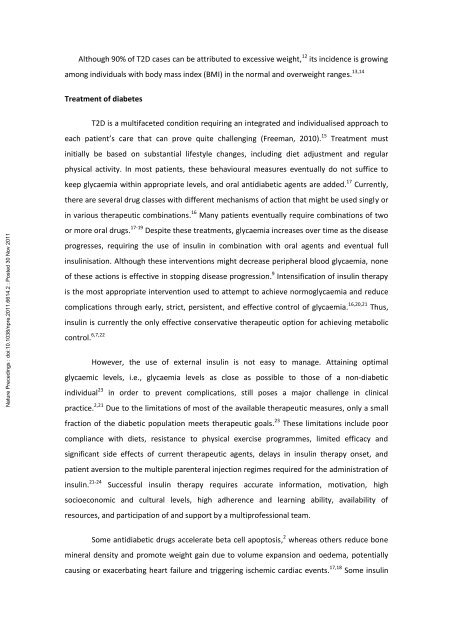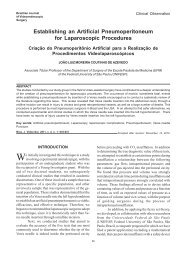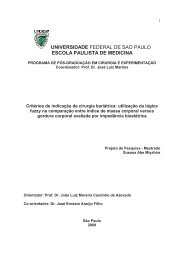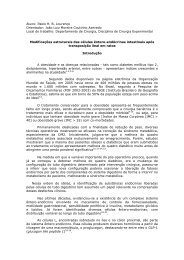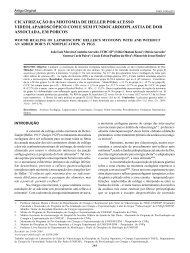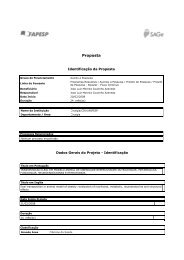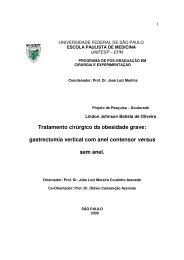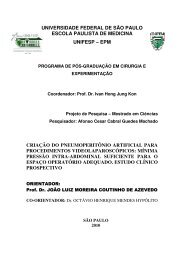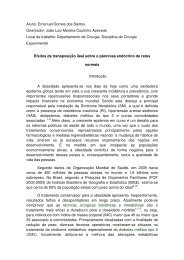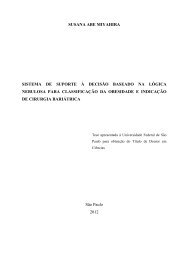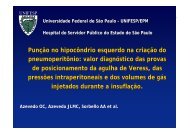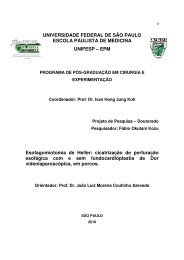Isolated ileal interposition in enteroendocrine L cells differentiation
Isolated ileal interposition in enteroendocrine L cells differentiation
Isolated ileal interposition in enteroendocrine L cells differentiation
Create successful ePaper yourself
Turn your PDF publications into a flip-book with our unique Google optimized e-Paper software.
Although 90% of T2D cases can be attributed to excessive weight, 12 its <strong>in</strong>cidence is grow<strong>in</strong>g<br />
among <strong>in</strong>dividuals with body mass <strong>in</strong>dex (BMI) <strong>in</strong> the normal and overweight ranges. 13,14<br />
Treatment of diabetes<br />
Nature Preced<strong>in</strong>gs : doi:10.1038/npre.2011.6614.2 : Posted 30 Nov 2011<br />
T2D is a multifaceted condition requir<strong>in</strong>g an <strong>in</strong>tegrated and <strong>in</strong>dividualised approach to<br />
each patient’s care that can prove quite challeng<strong>in</strong>g (Freeman, 2010). 15 Treatment must<br />
<strong>in</strong>itially be based on substantial lifestyle changes, <strong>in</strong>clud<strong>in</strong>g diet adjustment and regular<br />
physical activity. In most patients, these behavioural measures eventually do not suffice to<br />
keep glycaemia with<strong>in</strong> appropriate levels, and oral antidiabetic agents are added. 17 Currently,<br />
there are several drug classes with different mechanisms of action that might be used s<strong>in</strong>gly or<br />
<strong>in</strong> various therapeutic comb<strong>in</strong>ations. 16 Many patients eventually require comb<strong>in</strong>ations of two<br />
or more oral drugs. 17-19 Despite these treatments, glycaemia <strong>in</strong>creases over time as the disease<br />
progresses, requir<strong>in</strong>g the use of <strong>in</strong>sul<strong>in</strong> <strong>in</strong> comb<strong>in</strong>ation with oral agents and eventual full<br />
<strong>in</strong>sul<strong>in</strong>isation. Although these <strong>in</strong>terventions might decrease peripheral blood glycaemia, none<br />
of these actions is effective <strong>in</strong> stopp<strong>in</strong>g disease progression. 9 Intensification of <strong>in</strong>sul<strong>in</strong> therapy<br />
is the most appropriate <strong>in</strong>tervention used to attempt to achieve normoglycaemia and reduce<br />
complications through early, strict, persistent, and effective control of glycaemia. 16,20,21 Thus,<br />
<strong>in</strong>sul<strong>in</strong> is currently the only effective conservative therapeutic option for achiev<strong>in</strong>g metabolic<br />
control. 6,7,22<br />
However, the use of external <strong>in</strong>sul<strong>in</strong> is not easy to manage. Atta<strong>in</strong><strong>in</strong>g optimal<br />
glycaemic levels, i.e., glycaemia levels as close as possible to those of a non-diabetic<br />
<strong>in</strong>dividual 23 <strong>in</strong> order to prevent complications, still poses a major challenge <strong>in</strong> cl<strong>in</strong>ical<br />
practice. 2,21 Due to the limitations of most of the available therapeutic measures, only a small<br />
fraction of the diabetic population meets therapeutic goals. 23 These limitations <strong>in</strong>clude poor<br />
compliance with diets, resistance to physical exercise programmes, limited efficacy and<br />
significant side effects of current therapeutic agents, delays <strong>in</strong> <strong>in</strong>sul<strong>in</strong> therapy onset, and<br />
patient aversion to the multiple parenteral <strong>in</strong>jection regimes required for the adm<strong>in</strong>istration of<br />
<strong>in</strong>sul<strong>in</strong>. 21-24 Successful <strong>in</strong>sul<strong>in</strong> therapy requires accurate <strong>in</strong>formation, motivation, high<br />
socioeconomic and cultural levels, high adherence and learn<strong>in</strong>g ability, availability of<br />
resources, and participation of and support by a multiprofessional team.<br />
Some antidiabetic drugs accelerate beta cell apoptosis, 2 whereas others reduce bone<br />
m<strong>in</strong>eral density and promote weight ga<strong>in</strong> due to volume expansion and oedema, potentially<br />
caus<strong>in</strong>g or exacerbat<strong>in</strong>g heart failure and trigger<strong>in</strong>g ischemic cardiac events. 17,18 Some <strong>in</strong>sul<strong>in</strong>


